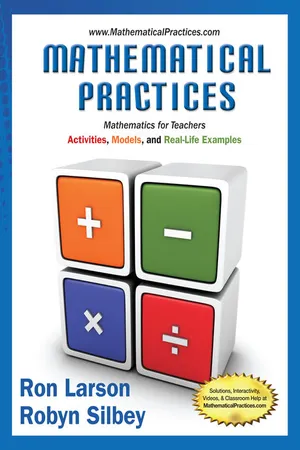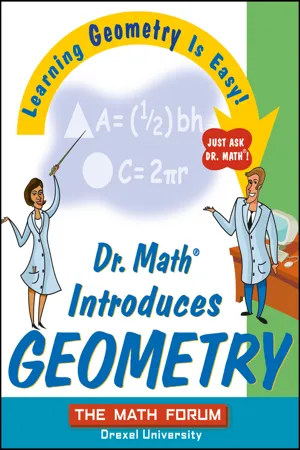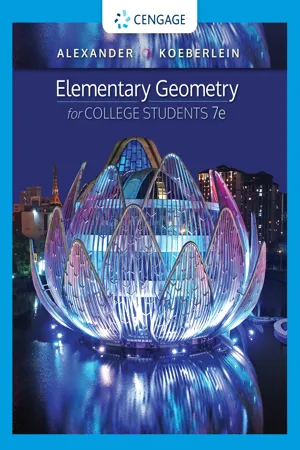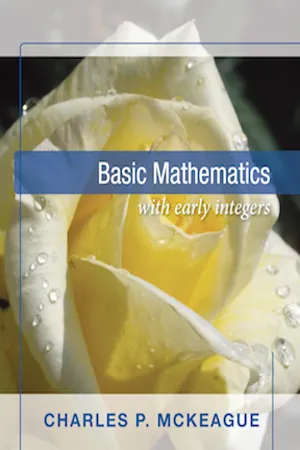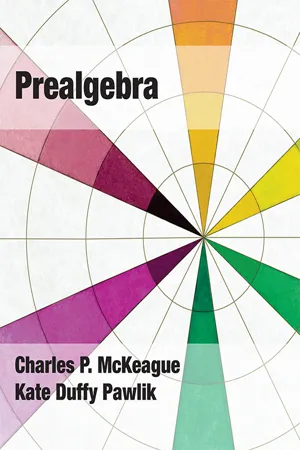Mathematics
Area of Circles
The area of a circle is the measure of the space enclosed by the circle's boundary. It is calculated using the formula A = πr^2, where A represents the area and r is the radius of the circle. The concept is fundamental in geometry and has practical applications in various fields such as engineering, physics, and architecture.
Written by Perlego with AI-assistance
Related key terms
1 of 5
8 Key excerpts on "Area of Circles"
- eBook - PDF
Mathematical Practices, Mathematics for Teachers
Activities, Models, and Real-Life Examples
- Ron Larson, Robyn Silbey(Authors)
- 2014(Publication Date)
- Cengage Learning EMEA(Publisher)
All Rights Reserved. May not be copied, scanned, or duplicated, in whole or in part. Due to electronic rights, some third party content may be suppressed from the eBook and/or eChapter(s). Editorial review has deemed that any suppressed content does not materially affect the overall learning experience. Cengage Learning reserves the right to remove additional content at any time if subsequent rights restrictions require it. Section 12.1 Circumferences and Areas of Circles 459 12.1 Circumferences and Areas of Circles Find the diameter and radius of a circle. Find the circumference of a circle. Find the area of a circle. Parts of a Circle Standards Grades K–2 Geometry Students should identify and describe shapes. Grades 3–5 Measurement and Data Students should understand concepts of angles and angle measurement. Grades 6–8 Geometry Students should solve real-life and mathematical problems involving area. Definition of a Circle A circle is the set of all points in a plane that are the same distance from a point called the center. Center Circle The radius is the distance from the center to any point on the circle. The diameter is the distance across the circle through the center. Radius and Diameter of a Circle Words The diameter d of a circle is twice the radius r. The radius r of a circle is one-half the diameter d. Algebra Diameter: d = 2r Radius: r = d — 2 EXAMPLE 1 Finding a Diameter and a Radius a. The diameter of a circle is 12 feet. b. The radius of a circle is 4.5 meters. Find the radius. Find the diameter. 12 ft 4.5 m SOLUTION a. r = d — 2 Radius of a circle b. d = 2r Diameter of a circle = 12 — 2 Substitute 12 for d. = 2(4.5) Substitute 4.5 for r. = 6 Divide. = 9 Multiply. The radius is 6 feet. The diameter is 9 meters. The tool used to draw a circle is called a compass. To use a compass, place the point at the center of a circle. Adjust the radius. Then rotate the compass so that the pencil draws the circle. - No longer available |Learn more
- Daniel C. Alexander, Geralyn M. Koeberlein, , , Daniel C. Alexander, Geralyn M. Koeberlein(Authors)
- 2014(Publication Date)
- Cengage Learning EMEA(Publisher)
A 1 2 r (2 p r ) or A p r 2 A 1 2 r (2 p r ) C 2 p r A 1 2 rC P S C a S r A 1 2 aP 8.4 ■ Circumference and Area of a Circle 371 Unless otherwise noted, all content on this page is © Cengage Learning. Figure 8.45 THEOREM 8.4.3 The area A of a circle whose radius has length r is given by . A p r 2 Another justification of the formula is found in the following Discover activity. A p r 2 D iscover AREA OF A CIRCLE Use a protractor to divide a circle into several congruent “sectors.” For instance, central angles will divide the circle into sectors. If these sectors are alternated as shown, the resulting figure approximates a parallelogram. This parallelogram has a base of length r (half the circumference of the circle) and an altitude of length r (radius of the circle). Based upon the formula , the area of the parallelogram (and of the circle) can be seen to be , or . r 2 p A r ) r p A ( A bh p 360 15 24 15 r π r EXAMPLE 6 Find the approximate area of a circle whose radius has a length of 10 in. Use . SOLUTION becomes . Then EXAMPLE 7 The approximate area of a circle is 38.5 cm . Find the length of the radius of the circle. Use SOLUTION By substituting known values, the formula becomes , or . Multiplying each side of the equation by , we have 7 2 22 77 7 2 7 22 22 7 r 2 7 22 77 2 22 7 r 2 38.5 22 7 r 2 A p r 2 p 22 7 . 2 A 3.14(100) 314 in 2 A 3.14(10) 2 A p r 2 p 3.14 Copyright 2013 Cengage Learning. All Rights Reserved. May not be copied, scanned, or duplicated, in whole or in part. Due to electronic rights, some third party content may be suppressed from the eBook and/or eChapter(s). Editorial review has deemed that any suppressed content does not materially affect the overall learning experience. Cengage Learning reserves the right to remove additional content at any time if subsequent rights restrictions require it. - eBook - PDF
Dr. Math Introduces Geometry
Learning Geometry is Easy! Just ask Dr. Math!
- (Author)
- 2004(Publication Date)
- Jossey-Bass(Publisher)
There’s an interesting way to see why this formula is true, which may help you remember it. (Though the easiest way to remember the formula is the old joke: why do they say “pie are square” when pies are round?) Picture a circle as a slice of lemon with lots of sections (I’ll only show six sections, but you should imagine as many as possible): Dear Dr. Math, I haven’t figured any of it out, but I want to know how to get the area of a circle. Please help. Yours truly, Lorraine Finding the Area of a Circle Now cut it along a radius and unroll it: All those sections (technically called sectors of the circle) are close enough to triangles (if you make enough of them) that we can use the triangle formula to figure out their area. Each triangle has an area that can be found using the formula Well, what part of the circle makes up the base of the triangles? The circumference, all spread out. What part of the circle makes up the height of each triangle? The radius is the height. That makes our area formula for one triangle But wait—there are six triangles, and you have to add them all together to get their total area, right? Well, if you divide the circum- ference by 6 to get the part that applies to each triangle, then you multiply it by 6 to get the total number of triangles, you’re back where you started. So since you know the whole length of the cir- cumference, you can use the formula just once to figure out the area of all six triangles, like this: A C r = ⋅ 1 2 1 6 A b h = ⋅ 1 2 Circles and Pi 97 98 Dr. Math Introduces Geometry You should know that the circumference is pi times the diameter, or C = πd = π ⋅ 2 r = 2π r so the area is just A r r r = π ⋅ = π 1 2 2 2 ( ) A C r C r C r C r C r = ⋅ ⋅ = ⋅ ⋅ ⋅ ⋅ = ⋅ ⋅ ⋅ ⋅ = ⋅ ⋅ ⋅ = ⋅ ⋅ 1 2 1 6 6 1 2 1 6 6 1 2 1 6 6 1 2 1 1 2 In other words, the area of a circle is just the area of a triangle whose base is the circumference of the circle and whose height is the radius of the circle. - eBook - ePub
Journey into Mathematics
An Introduction to Proofs
- Joseph J. Rotman(Author)
- 2013(Publication Date)
- Dover Publications(Publisher)
π is the area of a disk with radius 1.In the next section, we will be able to show that the definition of π just given coincides with the familiar definition.Corollary 3.10 .If D is a disk with radius r , thenarea(D ) = π r 2 .Proof. If D′ is the unit disk, then Theorem 3.8 givesSince area(D ′) = π, we have area(D ) = πr 2 , as desired.We feel superior to the Greeks because, nowadays, the area formula can be derived routinely using calculus. But let us see whether we have a right to be so smug. The area of a disk of radius r is given by the definite integralUsing the substitution: x = r sin θ , so that dx = r cos θdθ , we see that the indefinite integral isone now uses the double angle formula, to obtainTo evaluate the original definite integral, we must find the new limits of integration: as x varies over the interval [−r , r ], θ varies over the interval [0, π ]. But why is that? For us, π means the area of the unit disk; we have not yet established any connection between the area of a circle and its circumference. It follows that it is not yet legitimate to use radian measure, and so it is premature to use limits of integration for the new definite integral that mention π. Perhaps we should not feel so superior to the Greeks!Exercises3.9. A pizzeria charges $2.50 for a 10” pizza and $5.00 for a 15” pizza (a 10” pizza is circular with diameter 10 inches). Should four hungry students order four 10” pizzas or two 15” pizzas?3.10. Complete the proof of Theorem 3.8 by showing that A′/A > r ′2 /r 2 leads to a contradiction.3.11. The inscribed polygon P n consists of 2n +1congruent isosceles triangles, each with height hn .Prove that h * ↗ r ; that is, h 1 , h 2 , h 3 , ⋯ approximates r from below. (Hint: Using Figure 3.10 , express r − h n+1 and r − h n as cosines, and show that - eBook - PDF
- Daniel C. Alexander, Geralyn M. Koeberlein(Authors)
- 2019(Publication Date)
- Cengage Learning EMEA(Publisher)
DEFINITION 8.5 ■ More Area Relationships in the Circle 387 In Figure 8.51, the segment of the circle is bounded by chord AB and its minor arc AB C . Again, we avoid confusion by shading the segment whose area or perimeter we seek. EXAMPLE 4 In Figure 8.52, find the exact area of the segment bounded by the chord and the arc whose measure is 90°. SOLUTION Let A n represent the area of the triangle shown. Because A uni25B3 1 A segment 5 A sector , we see that A segment 5 A sector 2 A uni25B3 A segment 5 90 360 # p # 12 2 2 1 2 # 12 # 12 5 1 4 # 144p 2 1 2 # 144 5 (36p 2 72) in 2 In the figure for Example 4, the boundaries of the segment shown are chord AB and minor arc AB C . Therefore, the perimeter of the segment is given by P segment 5 AB 1 / AB C . We use this formula in Example 5. EXAMPLE 5 Find the exact perimeter of the segment shown in Figure 8.53. Then use your calculator to approximate this answer to the nearest hundredth of an inch. 12 in. 12 in. A B Figure 8.53 SOLUTION Because / AB C 5 90 360 # 2 # p # r, we have / AB C 5 1 4 # 2 # p # 12 5 6p in. Using either the Pythagorean Theorem or the 45°-45°-90° relationship, AB 5 12 !2 . Now P segment 5 AB 1 / AB C becomes P segment 5 (12 !2 1 6p) in. Using a calculator, we find that the approximate perimeter is 35.82 in. AREA OF A TRIANGLE WITH AN INSCRIBED CIRCLE Theorem 8.5.3 Where P represents the perimeter of a triangle and r represents the length of the radius of its inscribed circle, the area A of the triangle is given by A 5 1 2 rP SSG EXS. 7–11 Reminder The center of the inscribed circle of a triangle is determined by the angle bisectors of the triangle. A B Figure 8.51 12 in. 12 in. A B Figure 8.52 388 CHAPTER 8 ■ AREAS OF POLYGONS AND CIRCLES PICTURE PROOF OF THEOREM 8.5.3 GIVEN: A triangle with perimeter P, whose sides measure a, b, and c; the radius of the inscribed circle measures r. - eBook - PDF
- Charles P. McKeague(Author)
- 2015(Publication Date)
- XYZ Textbooks(Publisher)
The actual ratio of C to d in any circle is an irrational number. We can only approximate it with a fraction or a decimal. We use the symbol π (Greek pi) to represent this ratio. In symbols, the relationship between the circumference and the diameter in any circle is C __ d = π Knowing what we do about the relationship between division and multiplication, we can rewrite this formula as C = πd This is the formula for the circumference of a circle. When we do the actual calculations, we will use the approximation 3.14 for π. Because d = 2r, the same formula written in terms of the radius is C = 2πr C = circumference r = radius d = diameter C r r d r Note The irrational number π (pi) is usually approximated as a decimal with 3.14. When we wish to approximate π with a fraction, it is customary to use 22 __ 7 . Remember, neither number is an exact value for the number π. In this book, we use only the decimal approximation, 3.14. 420 Chapter 8 Geometry Find the circumference of each coin. a. 1 Euro coin (Round to the nearest whole number.) Diameter = 23.25 millimeters b. Susan B. Anthony dollar (Round to the nearest hundredth.) Radius = 0.52 inch Solution Applying our formulas for circumference, we have: a. C = πd ≈ (3.14)(23.25) ≈ 73 mm b. C = 2πr ≈ 2(3.14)(0.52) ≈ 3.27 in. The diameter of an inner tube at the Ravine Water Park is 42 inches. What is the circumference of the tube? Give your answer in inches as well as to the nearest foot. Solution Applying our formula for circumference, we have C = πd ≈ (3.14)(42) = 131.88 in. To convert inches to feet, we multiply by the correct conversion factor: 131.88 in. = 131.88 in. × 1 ft _____ 12 in. = 10.99 ft ≈ 11 ft Round to the nearest foot Circles and the Earth There are many circles found on the surface of the earth. The most familiar are the latitude and longitude lines. Of these circles, the ones with the largest circumference are called great circles. - eBook - PDF
- Charles P. McKeague(Author)
- 2011(Publication Date)
- XYZ Textbooks(Publisher)
DEFINITION DEFINITION The perimeter of any polygon is the sum of the lengths of the sides, and it is denoted with the letter P. DEFINITION P = 4s s square P = 2l + 2w l rectangle w P = a + b + c b h a c triangle Perimeter and Circumference 440 Chapter 8 Geometry EXAMPLE 1 Find the perimeter of the given rectangle. SOLUTION The given rectangle has a width of 5 yards and a length of 8 yards. We can use the formula for P 5 2l 1 2w to find the perimeter. We have: P 5 2(8) 1 2(5) 5 16 1 10 5 26 yards EXAMPLE 2 Find the perimeter of each of the following stamps. Write your answer as a decimal, rounded to the nearest tenth, if necessary. a. Each side is 35.0 millimeters b. Base 5 2} 5 8 } inches Other two sides 5 1} 7 8 } inches c. Length 5 1.56 inches Width 5 0.99 inches SOLUTION We can add all the sides together, or we can apply our formulas. Let’s apply the formulas. a. P 5 4s 5 4 ? 35 5 140 mm b. P 5 a 1 b 1 c 5 2 5 } 8 1 1 7 } 8 1 1 7 } 8 5 6 3 } 8 ≈ 6.4 in. c. P 5 2l 1 2w 5 2(1.56) 1 2(0.99) 5 5.1 in. Video Examples Section 8.1 8 yd 5 yd 8.1 Perimeter and Circumference 441 Circumference The circumference of a circle is the distance around the outside, just as the perim- eter of a polygon is the distance around the outside. The circumference of a circle can be found by measuring its radius or diameter and then using the appropriate formula. The radius of a circle is the distance from the center of the circle to the circle itself. The radius is denoted by the letter r. The diameter of a circle is the distance from one side to the other, through the center. The diameter is denoted by the letter d. In the figure below we can see that the diameter is twice the radius, or d 5 2r The relationship between the circumference and the diameter or radius is not as obvious. As a matter of fact, it takes some fairly complicated mathematics to show just what the relationship between the circumference and the diameter is. - eBook - PDF
- Charles P. McKeague, Kate Duffy Pawlik(Authors)
- 2014(Publication Date)
- XYZ Textbooks(Publisher)
We can only approximate it with a fraction or a decimal. We use the symbol π (Greek pi) to represent this ratio. In symbols, the relationship between the circumference and the diameter in any circle is C __ d = π Knowing what we do about the relationship between division and multiplication, we can rewrite this formula as C = πd This is the formula for the circumference of a circle. When we do the actual calcu- lations, we will use the approximation 3.14 for π. Because d = 2r, the same formula written in terms of the radius is C = 2πr C = circumference r = radius d = diameter C r r d r Note The irrational number π (pi) is usually approximated as a decimal with 3.14. When we wish to approximate π with a fraction, it is customary to use 22 __ 7 . Remember, neither number is an exact value for the number π. In this book, we use only the decimal approxima- tion, 3.14. 518 Chapter 8 Geometry Find the circumference of each coin. a. 1 Euro coin (Round to the nearest whole number.) Diameter = 23.25 millimeters b. Susan B. Anthony dollar (Round to the nearest hundredth.) Radius = 0.52 inch Solution Applying our formulas for circumference we have: a. C = πd ≈ (3.14)(23.25) ≈ 73 mm b. C = 2πr ≈ 2(3.14)(0.52) ≈ 3.27 in. The diameter of an inner tube at the Ravine Water Park is 42 inches. What is the circumference of the tube? Give your answer in inches as well as to the nearest foot. Solution Applying our formula for circumference, we have C = πd ≈ (3.14)(42) = 131.88 in. To convert inches to feet, we multiply by the correct conversion factor: 131.88 in. = 131.88 in. × 1 ft _____ 12 in. = 10.99 ft ≈ 11 ft To the nearest foot Circles and the Earth There are many circles found on the surface of the earth. The most familiar are the latitude and longitude lines. Of these circles, the ones with the largest circumfer- ence are called great circles. All of the longitude lines are great circles. Of the lati- tude lines, only the equator is a great circle.
Index pages curate the most relevant extracts from our library of academic textbooks. They’ve been created using an in-house natural language model (NLM), each adding context and meaning to key research topics.
